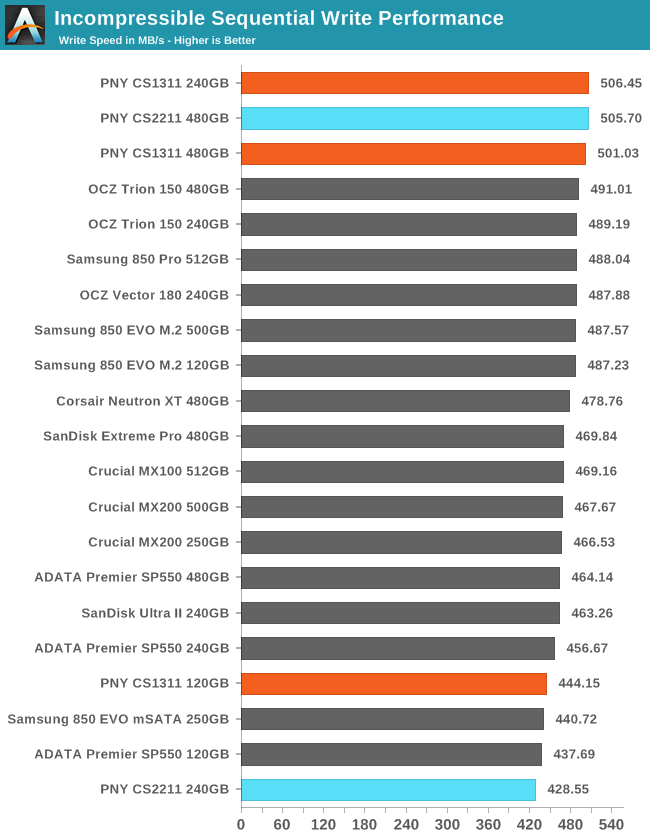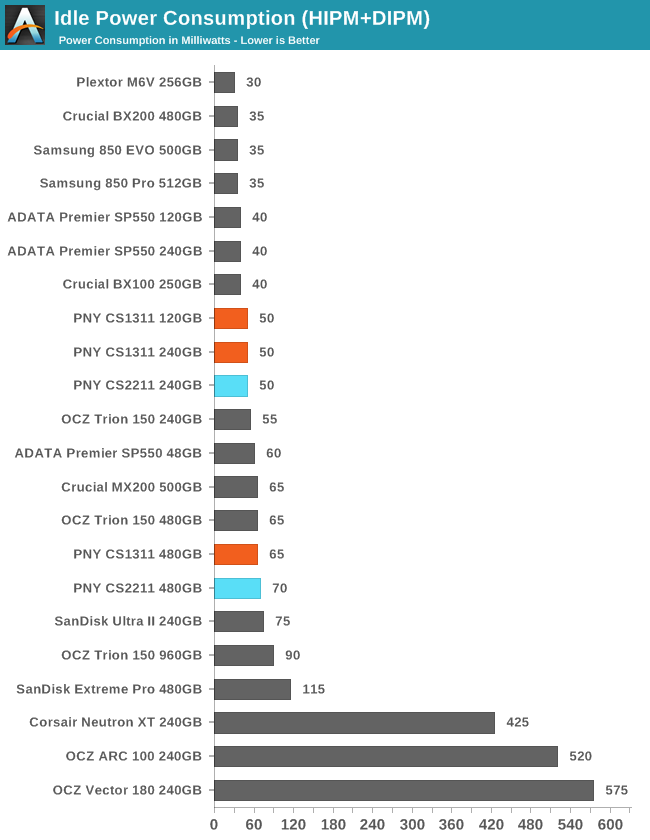The PNY CS1311 and CS2211 SSD Review: MLC vs TLC at 15nm
by Billy Tallis on April 15, 2016 8:00 AM ESTATTO
ATTO's Disk Benchmark is a quick and easy freeware tool to measure drive performance across various transfer sizes.
 |
|||||||||
Aside from the 120GB drive's hobbled write speed, everything looks normal with the ATTO plots. The 120GB drive is just too small to deliver the full performance its controller is capable of, even though it's the smaller variant of the S10.
AS-SSD
AS-SSD is another quick and free benchmark tool. It uses incompressible data for all of its tests, making it an easy way to keep an eye on which drives are relying on transparent data compression. The short duration of the test makes it a decent indicator of peak drive performance.


Peak sequential read speeds of the PNY drives are all top-notch, but the 240GB CS2211 is oddly slow on the write test.
Idle Power Consumption
Since the ATSB tests based on real-world usage cut idle times short to 25ms, their power consumption scores paint an inaccurate picture of the relative suitability of drives for mobile use. During real-world client use, a solid state drive will spend far more time idle than actively processing commands. Our testbed doesn't support the deepest DevSlp power saving mode that SATA drives can implement, but we can measure the power usage in the intermediate slumber state where both the host and device ends of the SATA link enter a low-power state and the drive is free to engage its internal power savings measures.
We also report the drive's idle power consumption while the SATA link is active and not in any power saving state. Drives are required to be able to wake from the slumber state in under 10 milliseconds, but that still leaves plenty of room for them to add latency to a burst of I/O. Because of this, many desktops default to either not using SATA Aggressive Link Power Management (ALPM) at all or to only enable it partially without making use of the device-initiated power management (DIPM) capability. Additionally, SATA Hot-Swap is incompatible with the use of DIPM, so our SSD testbed usually has DIPM turned off during performance testing.


The S10C controller does seem to save a bit of power over the larger S10-X, with and without ALPM. The S10C sets a new record for the best idle power without ALPM.










43 Comments
View All Comments
futrtrubl - Saturday, April 16, 2016 - link
How is that not good enough? That's 3 years if you rewrite the ENTIRE drive EVERY DAY.Let's pick a long 9 year planned lifetime for a drive as you would probably want to upgrade by then for non-failure reasons. That means you could write 1/3 of the drive's capacity every day for those nine days. For a 256GB drive (somewhat on the small end now) that's 85GB every day. Or installing 2-3 AAA games every day!
bug77 - Sunday, April 17, 2016 - link
Well, on a modern OS you no longer control the amount of data being written. Automatic updates, indexing, metadata, restore points... the OS will write those whenever it wants to.If planar TLC was half the cost of MLC or V-NAND TLC, I may consider it. But since it's within 10-20%, I'd rather get the better drive.
doggface - Tuesday, April 19, 2016 - link
The average laptop user writes 10-20gb a day. Even if you were double average you would still be safe as houses.BrokenCrayons - Thursday, April 21, 2016 - link
I have a modern OS on my laptop and have quite a bit of control over what does or doesn't get written to storage. For instance, there are no restore points, indexing is mine to manage as I see fit. I can pick when and what I want to update, and I haven't allocated a partition to swap (thank you Linux). You just have to exercise a bit of selectivity about which modern OS you decide to install.rarson - Monday, April 18, 2016 - link
In my experience, the average mechanical hard drive has a life of about 2 years. I see many of them fail before then, and most of the drives these that last over 5 years are already 8+ years old.I recently bought one of Seagate's 8TB archival drives and it started making some clicking noises right out of the box. It hasn't given me any problems yet, but it is a bit disconcerting to hear a click every couple minutes. Hard drives just don't last very long anymore, while my SSDs have been rock solid with everyday use. I would not install my operating system on a mechanical drive ever again. No reason to do so.
fire400 - Monday, May 23, 2016 - link
i put windows XP on this 1311, and it's the fastest I've ever seen XP do anything, startup, tasks, and installing software and launching programs, faster than high end workstation systems on HDD's, since it's debut in 2001... loland yes, the XP OS is extremely stable because the 1311 takes care of garbage collection in the background.
burn tested it for several hours and days on end, it's perfect...
LB-ID - Friday, April 15, 2016 - link
I can't imagine buying any PNY products in any event, but even more so given that the Samsung EVO is so much more bang and reliability for your buck.DigitalFreak - Friday, April 15, 2016 - link
Every PNY device I've had, whether SD cards or video cards, has died prematurely. Absolute garbage.The_Assimilator - Friday, April 15, 2016 - link
That's what the "XLR8" part stands for!TheinsanegamerN - Wednesday, April 20, 2016 - link
My pny 770s are going strong 2.5 years later. Also some of the coolest running 770s I've seen